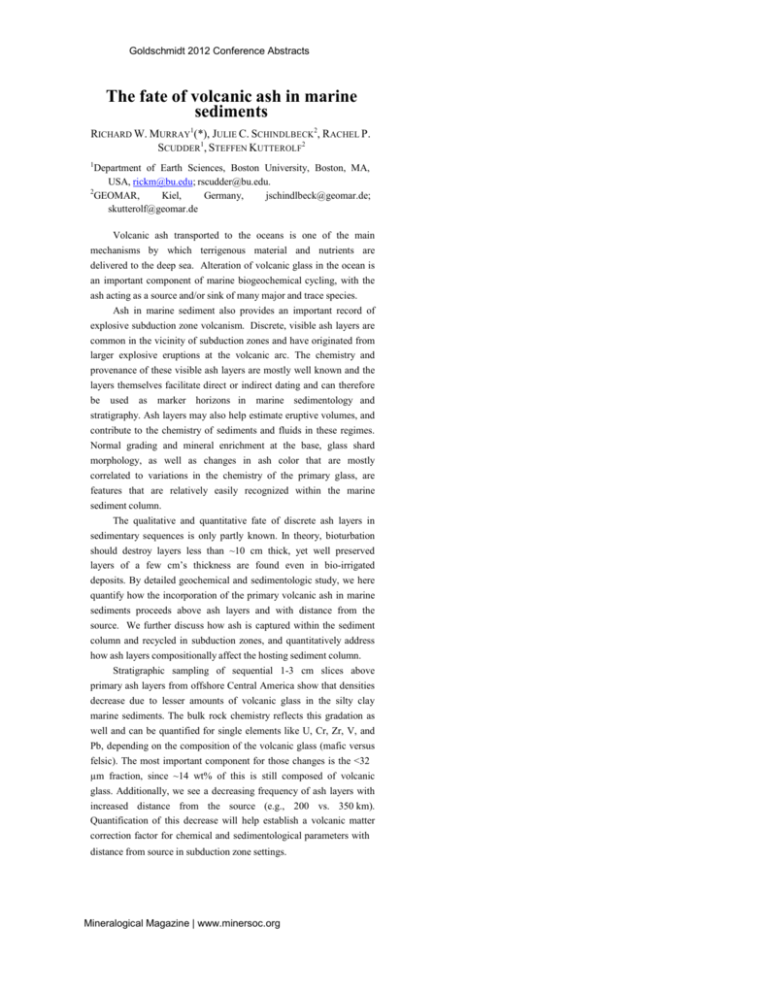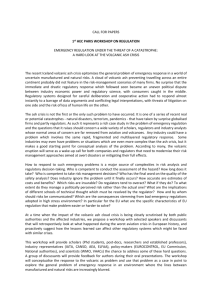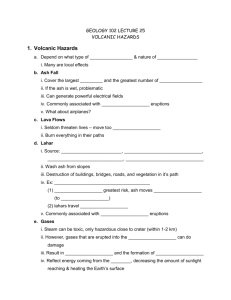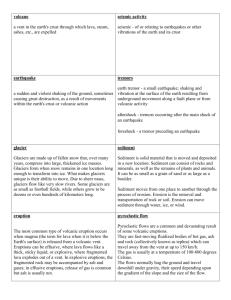Goldschmidt 2012 Conference Abstracts The fate of volcanic ash in
advertisement

Goldschmidt 2012 Conference Abstracts The fate of volcanic ash in marine sediments RICHARD W. MURRAY1(*), JULIE C. SCHINDLBECK2, RACHEL P. SCUDDER1, STEFFEN KUTTEROLF2 1 Department of Earth Sciences, Boston University, Boston, MA, USA, rickm@bu.edu; rscudder@bu.edu. 2 GEOMAR, Kiel, Germany, jschindlbeck@geomar.de; skutterolf@geomar.de Volcanic ash transported to the oceans is one of the main mechanisms by which terrigenous material and nutrients are delivered to the deep sea. Alteration of volcanic glass in the ocean is an important component of marine biogeochemical cycling, with the ash acting as a source and/or sink of many major and trace species. Ash in marine sediment also provides an important record of explosive subduction zone volcanism. Discrete, visible ash layers are common in the vicinity of subduction zones and have originated from larger explosive eruptions at the volcanic arc. The chemistry and provenance of these visible ash layers are mostly well known and the layers themselves facilitate direct or indirect dating and can therefore be used as marker horizons in marine sedimentology and stratigraphy. Ash layers may also help estimate eruptive volumes, and contribute to the chemistry of sediments and fluids in these regimes. Normal grading and mineral enrichment at the base, glass shard morphology, as well as changes in ash color that are mostly correlated to variations in the chemistry of the primary glass, are features that are relatively easily recognized within the marine sediment column. The qualitative and quantitative fate of discrete ash layers in sedimentary sequences is only partly known. In theory, bioturbation should destroy layers less than ~10 cm thick, yet well preserved layers of a few cm’s thickness are found even in bio-irrigated deposits. By detailed geochemical and sedimentologic study, we here quantify how the incorporation of the primary volcanic ash in marine sediments proceeds above ash layers and with distance from the source. We further discuss how ash is captured within the sediment column and recycled in subduction zones, and quantitatively address how ash layers compositionally affect the hosting sediment column. Stratigraphic sampling of sequential 1-3 cm slices above primary ash layers from offshore Central America show that densities decrease due to lesser amounts of volcanic glass in the silty clay marine sediments. The bulk rock chemistry reflects this gradation as well and can be quantified for single elements like U, Cr, Zr, V, and Pb, depending on the composition of the volcanic glass (mafic versus felsic). The most important component for those changes is the <32 µm fraction, since ~14 wt% of this is still composed of volcanic glass. Additionally, we see a decreasing frequency of ash layers with increased distance from the source (e.g., 200 vs. 350 km). Quantification of this decrease will help establish a volcanic matter correction factor for chemical and sedimentological parameters with distance from source in subduction zone settings. Mineralogical Magazine | www.minersoc.org







